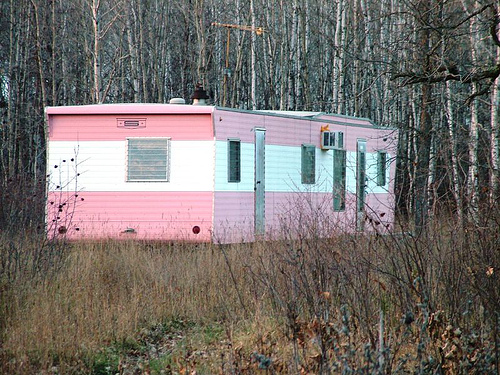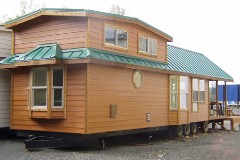 Seattle is having a cold snap. It’s 25 degrees outside. Our rare freezing winter days correspond with equally rare clear winter skies. Days like this make me wish I had a solar powered home that could harvest and store that free burst of energy for later use.
Seattle is having a cold snap. It’s 25 degrees outside. Our rare freezing winter days correspond with equally rare clear winter skies. Days like this make me wish I had a solar powered home that could harvest and store that free burst of energy for later use.
The bottom line is that American homes are just too large to be cost effectively heated with solar energy. The push has been to get the cost of solar panels down. But, what would you get if you crossed an expensive solar heating and cooling system with an optimally sized home? By optimal, I mean not larger than you need. You would get an affordable solar powered home like the one shown above (click here to see the details).
By affordable, I mean in the $150-200 thousand range excluding land, sewer, and water systems. Picture the north face with fancy wood and slate trim, a deck off of the loft doubling as a carport, double french doors, and lots and lots of windows (and window plugs). Essentially, this is a well insulated 10 x 40-foot park model trailer stocked with highly energy efficiency dual mode gas/electric appliances, and lots of diode lighting under a standardized solar energy system optimized for a given area of the country. Picture an entire neighborhood (or trailer park or commune) of these all facing south. Ninety percent of the people on this planet would jump at the chance to live in a home like that. Home size is relative, dependent on wealth and how far the “my house is bigger than yours” arms race has progressed. It’s all a matter of perception.


The total cost would be low because the house would cost very little — it is prefabricated and designed for optimal size and energy efficiency. Instead of a house that costs far more than its heating and cooling system, the heating and cooling system would cost far more than the house. Park model trailers are not what they used to be. Check out some of these interiors and hold on to your seat in case you get dizzy.
Like a Prius, the system pulls out all the engineering stops to maximize efficiency. And, like a Prius, it requires a computer program to optimize performance. Your (solid-state, low-power) home computer would have a screen showing exactly where all your energy is going, how dirty your PV panels are, how much heat is being lost to the night air, and anything else you can think of. You would be hyper aware of your energy use. You would also be able to change program parameters with a few mouse clicks, giving a higher priority on some days to charging the lithium batteries in your car, for example.
The computer would asses the system minute to minute, deciding how to best store the energy surplus and draw down stored energy. Several sunny days in Seattle might top off hot water and battery storage. Or the PVC panels might be diverted from hydrogen and battery charging to electric heating coils to help the solar trough and flat plate panels make hot water. A hole in the clouds might prompt the computer to shut down the hydrogen burning furnace and instead draw hot air from that part of the solar trough concentrator dedicated to hot air instead of water. It might draw on the batteries for heating the house if the hot water is low. It might burn hydrogen directly in a 95% efficient forced air furnace. Many appliances, like the stove, refrigerator, furnace, and dryer could be dual mode, capable of using gas or electricity.
An oversized system would sometimes top off all storage and sit idle while the sun beats down on it — or it might send some power to a neighbor. This is how all power grids work. Let’s say for example that this house is part of a closely spaced community of such houses (trailer park, neighborhood, commune) all hooked together into their own smart grid. There might even be a communal hydrogen tank farm. A less expensive, slightly undersized system would need to draw occasionally on a larger power grid when the sun stays hidden for months at a time, as can happen in Seattle.
This could all be done with off-the-shelf components. Hydrogen generators are available on the market today. Nothing new needs to be invented. If you lived in the Puget Sound area, your system might have been designed to optimize the size of the hydrogen storage tank and number of PVC panels to take advantage of the long sunny days of summer, harvesting and storing solar energy for the long dark winter. In Tucson, where the biggest problem is cooling dry air, the system might optimize battery storage to run your swamp cooler into the night and the hot water storage for heating on winter nights. You might have little need to produce and store hydrogen.
Maybe you could live in a small condo that costs only $20-$40 a month to heat and light. But not everyone wants to live in a condo.
What makes a bigger house more desirable? A bigger house isn’t more comfortable. I know from experience, having lived for several years in an 8′ x 30′ park model trailer located in a very nice park adjacent to a bike trail and a mile from the University of Washington campus with my wife-to-be while she finished graduate school and I worked at Boeing. Talk about easy to clean. But what if hybrid solar homes eventually garner even greater status and resale values than McMansions? Big houses may become a liability in the future. You never know.
Can small living spaces be just as comfortable as large ones? Absolutely, if properly designed. The trailer we lived in had a large sliding glass door and big windows in the living room that let the light pour in. We had lots of hanging plants and even had our own garden plot. It was an extremely comfortable place for a young couple to live. Cozy best describes it.
The park was nicely landscaped and had a small outbuilding with a communal washer and dryer as well as an extra bathroom, which is the same arrangement we found at the 1.2 million dollar houseboat of similar size on Lake Union we recently checked on during an open house. The park was eventually sold to a developer and now has office buildings on it. I was forced to sell our cozy home (for the same $4,000 I paid for it) and eventually purchased the house we now live in using the money saved by living so frugally. We look back to those days with nostalgia. It is unlikely we would still be there had the park not been sold, but hey, you never know.
An elderly couple lived next door to us in a much larger trailer (10′ x 40′). Trailer parks have their hierarchies like every other human group. They loved their small home and had raised two children in it. Essentially, they had traded working their asses off to impress other people with a big house for a life of leisure and an early retirement instead. What a concept!
We have friends who live in a nice home in San Diego. They recently purchased a trailer in a nice park as a stopover to cut a long commute to work in half. I think they may have paid a few hundred thousand dollars for it.
Trailer life not your cup of tea? The Moda Condos, which I believe are still under construction, are reasonable living spaces in downtown Seattle. The smaller units are less than 400 square feet and sold for less than $150,000. They sold out almost immediately, and I can see why. Drag your cursor over those links and check out the fixtures and trim they put in those things. Some of these condos will have only one of six sides exposed to the weather. I’ll wager that the total heating and electric bill isn’t much more than $20 a month.
Interestingly enough, many of these condos do not have parking spaces, which would have cost as much as $40,000. Is it true you can have a comfortable life and a low-carbon footprint?
I’ve been in several downtown condos this year. One was recently sold for three million dollars, commanded two floors and had two walls of solid glass, one of which was facing Elliot bay. The thermostats on the electric heaters didn’t work so the owner controlled the heat by opening and closing windows! An elderly gentleman who recently passed away owned it. We can’t take it with us.
The others were two-bedroom units of approximately five or six hundred square feet. The one with a view of Elliot bay cost $750,000. Views are an expensive option. They impress new visitors but not repeat visitors. I was just in that condo last week and have no recollection of having looked out the window. I would have been just as impressed with a large flat screen TV connected to a moveable zoom lens web camera mounted on a pole on the roof. Everyone could have a 360 view and telescope all in one package.


